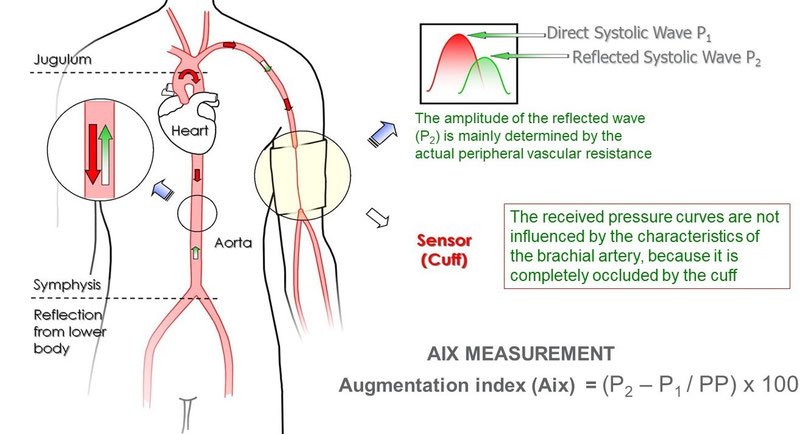Augmentation Index (AIx)
The Augmentation Index (AIx) is used as an indirect measure to assess the stiffness of arteries, which reflects the flexibility of blood vessels—a crucial aspect of cardiovascular health. When blood is pumped from the heart, a pressure wave is created, traveling down the arteries but partially bouncing back. This reflection, or “bounce-back” of the wave, is measured by AIx to provide insights into how well the arteries function.
In cases where arteries are stiff, the reflected wave returns more quickly and merges with the original wave, causing an increase in the pressure that the heart must handle. This added pressure can indicate a higher workload for the heart, potentially increasing the risk of cardiovascular issues, like heart disease. A higher AIx score is often linked to a greater strain on the heart over time.
In a nutshell, the Augmentation Index reflects on the "Total Peripheral Resistance" (TPR) and endothelial function in arterioles and small arteries.
Example Describing the Augmentation Index
Imagine you're watering your garden with a hose:
- The water initially flows forward smoothly, representing the forward wave generated by the heart pumping blood into the arteries.
- Now imagine the water hits the end of the hose or a kink and bounces back. This is like the reflected wave in your arteries when blood hits smaller vessels and changes direction.
In healthy, elastic arteries, the reflected wave arrives back during diastole, helping to maintain blood flow without significantly increasing the workload on the heart. However, in stiff arteries, the reflected wave comes back earlier, during systole, which increases the pressure the heart has to pump against.
How is Augmentation Index (AIx) calculated?
The AIx calculation involves measuring the extra pressure from the reflected wave by comparing two pressure peaks in each heartbeat. The formula is as follows:
AIx = 100 × ((P2-P1)/ (Pulse Pressure)).
In this formula, P2 represents the pressure peak from the reflected wave, while P1 represents the initial wave peak from the heart’s direct pump.
Example Calculation of the Brachial Augmentation Index
Suppose an adult has the following measurements:
Systolic pressure: 120 mmHg
Diastolic pressure: 80 mmHg
P1 (initial peak): 115 mmHg
P2 (reflected wave peak): 125 mmHg
Step 1: Calculate Pulse Pressure (PP)
PP = Systolic − Diastolic = 120 − 80 = 40 mmHg
Step 2: Calculate the Augmentation (P2 − P1)
P2 − P1 =1 25 − 115 = 10 mmHg
Step 3: Plug into AIx formula
AIX= 100 x (10/40) = 25%
Result: AIx = 25%
This is a typical brachial AIx for a healthy adult with elastic arteries.
Lower AIx values indicate that the reflected wave arrives later in the heartbeat (during diastole), meaning the heart does not face extra pressure from stiff arteries.
The Importance of the Augmentation Index measurement
The Augmentation Index (AIx) is a valuable tool for providing an early cardiovascular assessment, even in individuals without noticeable symptoms. High AIx scores are linked to an increased risk of cardiovascular issues, including coronary artery disease, making it an important marker for predicting potential heart conditions.
In addition to indicating arterial stiffness, AIx also reflects the body’s response to nitric oxide (NO)—a molecule produced by blood vessels to promote relaxation and flexibility in the arteries.
Overall, the Augmentation Index offers a quick and noninvasive way to evaluate arterial health and heart workload. With AIx measurements, healthcare providers can gain a more comprehensive understanding of a patient’s cardiovascular status. This insight enables more informed recommendations for lifestyle adjustments or medical treatments to reduce cardiovascular risk effectively.
An aortic AIx value under 33% is considered normal, indicating healthy arterial function. Values above 33% may suggest increased stiffness in the arteries or heightened resistance in smaller blood vessels. AIx is often preferred in clinical settings due to its simplicity; unlike other measures, it can be easily adjusted using blood pressure medications, making it especially practical for patients with hypertension



